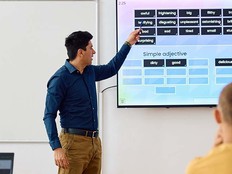Covering the Last Mile
Covering the Last Mile
Chris Rother

Fed up with the inequities between wealthy and low-income school districts, Roberta Weintraub wished more kids could sit in classrooms designed at the turn of the 21st century instead of the 20th.
In 2004, she delivered by welcoming students to High Tech High – Los Angeles’ new state-of-the-art building, complete with one-to-one computing and a laundry list of hardware and educational software.
“We have the classroom of the future today,” says Weintraub, High Tech High’s founder. “That doesn’t mean we have the classroom of the future tomorrow. There’s never any point where you say ‘enough.’
” Since the premiere of computers in schools, education leaders have dreamed of the “classroom of the future,” and they’ve strived to secure the next piece — whether it was high-speed Internet or an affordable projector — to create a digital classroom and cover that last mile in education technology.
Thanks to falling prices and technology’s ever-increasing presence, digital classrooms with computers, projectors, interactive whiteboards, digital cameras and printers are no longer the stuff of dreams. The rapid pace of technological change ensures there will always be something newer and better to strive for; a growing number of schools have built classrooms where technology is successfully integrated into the curriculum. The rest of us can learn from their insight into what it takes to get where they are and how to make the most of these tools once we arrive.
Perhaps the most important lesson is that the technology itself is the least complex part of creating a modern classroom. “What we really have to get down to is how kids learn best,” says John Kuglin, director of technology at Eagle County School District in Colorado.
Look at the schools making headlines for dropping their notebook programs because teachers can’t compete with technology for students’ interest. High Tech High uses technology to connect with students who have never known a world without it. “It’s harder to compete for their attention with just a blackboard and a teacher,” Weintraub says.
At Springfield Township High School in northwest Pennsylvania, teachers in the district’s first fully digital classrooms are incorporating interactive Web 2.0 technologies into the curriculum, explains Michael Wagman, director of technology at the district. Students use wikis and blogs to collaborate and share their writing with authentic audiences and they also create word-of-the-day podcasts.
Another struggle for “classrooms of the future” is maintenance. High Tech High insists on five-year warranties on all notebook computers. Springfield Township keeps maintenance in check by tying notebooks to the classrooms and letting students store files on networked servers.
A long-term sustainability plan that addresses maintenance, upgrades and replacements is a critical element of classrooms of the future. “You can’t ratchet up expectations and then pull them out three years later because you can’t sustain it,” Wagman says.
Impossible Dream?
With the highest test scores in Los Angeles, High Tech High’s students are living proof of the difference technology can make to learning. But founder Roberta Weintraub says the public education system will never be able to equip every child with a notebook computer.
High Tech High is small and has foundation support, but it’s too costly to give every student in America a notebook, she insists.
While Massachusetts Institute of Technology engineers are working to design a $100 notebook, Weintraub remains skeptical. But as the ranks of digital classrooms grow, educators continue to envision the classroom of the future.
“I’d like to see technology so well integrated in schools that it doesn’t garner attention,” says Michael Wagman, IT director at Pennsylvania’s Springfield Township School District.
Five Ideas You can Borrow from tomorrow’s classrooms:
- Pennsylvania’s Springfield Township High School lets tech-savvy students work the IT help desk in exchange for course credit.
- Colorado’s Eagle County School District is putting 42-inch LCD TVs in classrooms instead of projectors. They’re comparable in price and can function as projectors and TVs with built-in speakers.
- High Tech High – Los Angeles uses a “nanny cam” to monitor notebooks centrally and ensure that students don’t use them inappropriately.
- Springfield Township uses a teacher to coach his most enthusiastic peers, who in turn can train and inspire others.
- Eagle County is rebuilding its network with dynamic bandwidth, which provides a more-than-ample pipeline, but the district can purchase broadband in increments based on need.






